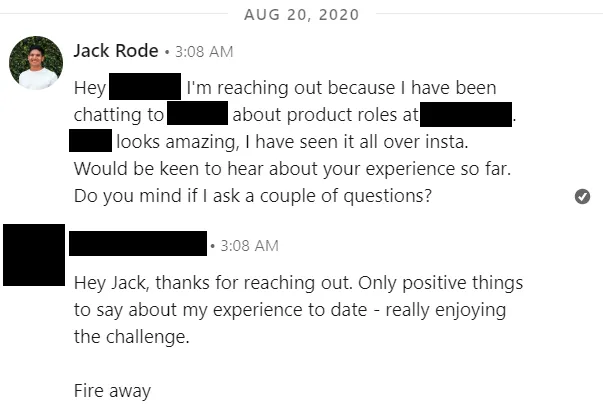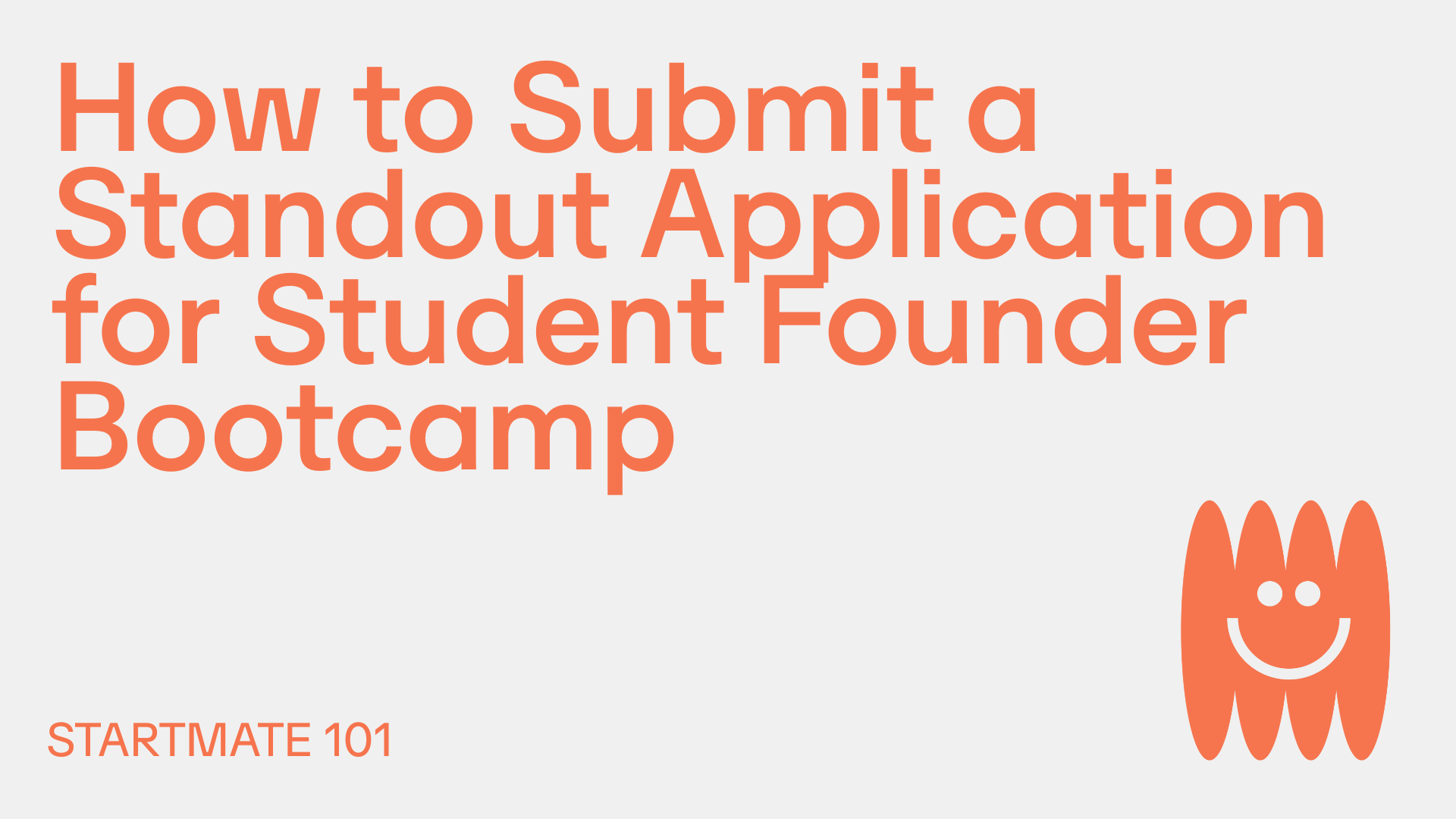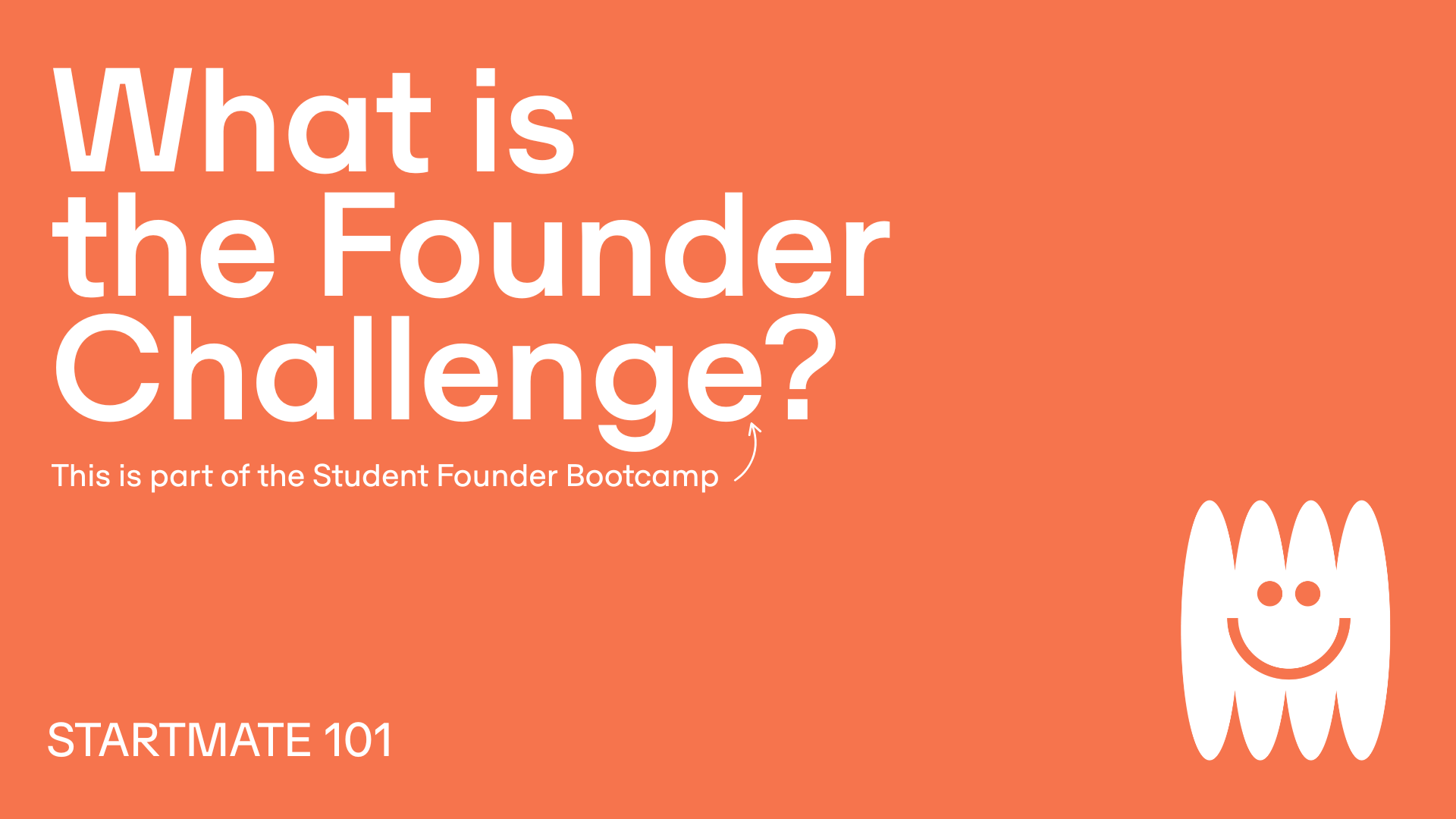Job searches are hard. Fear and self doubt drives people to believe that they can’t land anything, so they apply for everything.
Here’s a secret
Very few people actually think about what they want, because they don’t believe it’s achievable. The result is that everyone ends up applying for the same roles in the market. Whilst everyone else competes for the same roles, there is an opportunity to chase a role that actually excites you. Ironically, these may be easier to land.
In this post I’ll outline how I used this insight to land me 2 x startup internships and my role at Mr Yum. I’ve also used this method to coach a number of Startmate fellows into their first startup role.
Step 1: Find your ‘best answer’
The first mistake I see students and early grads making is jumping into a job hunt without ever asking themselves what they actually want. Our aspirations are so often influenced by what everyone else is doing around us. Product management, strategy, operations… are these things that you really want, or do they just sound cool?
So then, how do we figure out what we really want?
Most people start by looking at what’s out there and pick the shiniest, sexiest looking roles. They then form a story around why that job is their goal, it’s top down. This leads to some pretty uninspiring one-liners:
I want to be a management consultant because I love solving problems and want to make an impact on society.
How many times have you heard this one before?
Unless you have a standout resume, this approach won’t get you through the door. The way to stand out is by telling a compelling story—one that links your authentic curiosities and interests to the role you are applying for. I call this the ‘best answer’.
The first step in finding your best answer is to develop a deep understanding of your unique strengths and interests. Here are 5 questions/exercises that helped me inquire into these:
1) What do you spend most of your free time thinking about?
2) What comes easy to you, but is hard for others?
3) If you had unlimited money, what would you spend your time doing?
4) If you could guarantee effortless success at one thing, what would you pick?
5) Write down every task or activity that you would enjoy doing. Write tasks (sell a product) rather than roles (sales person). Pick the top 3 from your list.
Tips for answering these:
- Put aside 3-4 hours to answer these on a pen and paper with no distractions.
- Throw away all constraints, assume anything and everything is possible.
- Boredom is your friend. If you find yourself starring at a blank piece of paper, you’re nailing the exercise - wait and see what comes to mind.
Do this exercise and you will discover your life’s true calling - right? Wrong. We’re not looking for all the answers, we’re looking for a ‘best’ answer. Once you’ve answered the questions, see if you can boil down your curiosities and interests into a few sentences. Remember, it’s not your final answer. It’s your best answer at this point in time that you’ll use for further discovery.
Here’s the ‘best answer’ I used to land my role at Mr Yum:
I want to work for a company that is a) small enough where I can work closely with the founders, b) is building a consumer facing product that my friends and I would use, and c) is full of smart and talented people that I can learn from.
I would like to work as close to the customer as possible, understand their needs and map out how to deliver on these needs.
One session answering these questions will likely not get you to an answer like this, but it will act as a starting point. This answer took me months to figure out, but it became incredibly useful for the next step.
Step 2: Tell everyone
How do you turn your best answer into an even better answer? Tell everyone.
Start with your inner circle
Ask your close friends and family:
- What do you think I’m good at?
- What role do you think I would nail?
- What do you think I’d enjoy?
Next, pitch them your best answer and take note of their reaction. Throughout this process you’ll likely notice that there are things that don’t add up, things that don’t fit. From there you can refine your best answer to align it even more closely with your authentic self.
Next, it’s time to enter the ecosystem
If you take only one thing from this post, it’s this: one message per day. Cold outreach is daunting in the beginning. Pushing through the fear of rejection and gaining momentum is the most difficult part. To tackle this back in the day, I decided to commit to messaging one new person per day until I landed a role. I found that once I got 5 days in, the fear completely fell away and I was averaging 2 or 3 new messages daily. Small steps frequently almost always beats big steps infrequently.
What’s the point of all of this?
The purpose of these conversations is to stress test your best answer in the wild. You want to test all your assumptions about certain roles, companies and career pathways. This allows you to understand what roles and companies are out there, and where you fit in the industry. So many roles aren’t even advertised, and cold outreach is a great way to access these. In addition to building a mental map of the ecosystem, you’re also building your network. Authenticity and vulnerability builds trust, and trust builds relationships. Hopefully after a few weeks of outreach you’ll have a group of people in the industry cheering you on for success. Over time you will also refine your best answer and build more conviction behind it.
Here’s an example from 2020

Here I’ve asked whether I could send a few questions via Linkedin first. Often this can lead to a call where you can build more of a relationship and hear more detailed answers. Even if your response rate is only 10%, over 100 days that’s 10 conversations, and you may only need one to land you a role.
Tips for your outreach
- Start with your 1st Linkedin connections, then move onto your 2nd and 3rd connections. Ask your network for warm referrals if it feels appropriate.
- For larger companies (20+): start from the bottom of the org chart as you’re more likely to get a response. Impress them and see if they’ll refer you to others.
- For smaller companies (<20): I’ve actually found a lot of success going directly to the founders can work well.
- Find communication channels that have the least amount of traffic. Linkedin is quite flooded these days, try Twitter, email, Substack, in-person events - get creative. Ask yourself: “Where is no one else looking?”
- These days I’ve seen Startmate fellows with 90% conversion rates for their outreach. By joining these programs you get ‘trust by association’ that allows you to reach more people and land more meetings.
- People often don’t like to tell you that they hate their job or company. A hack is to find someone who recently moved out of their role/company, as they will give you the most balanced view.
The most important thing to keep in mind here is: you are not asking for a job, yet.
“Ask for a job, get advice. Ask for advice, get a job.”
Reaching out and asking for a job directly can sometimes put people on the defence, they may give you a hard no. On the other hand, some people may not be willing to jump on call with you to talk about something that isn’t concrete. It’s a tough balance to strike and you’ll get better at intuiting the right approach with practice.
How to prepare
Over prepare for these meetings. Find out everything there is to know about the person, and the company. Come prepared with high quality questions that you genuinely want the answer to. There is nothing worse than joining a catch up, where someone just wants to ‘pick your brain’. You want to present your best answer clearly, and then ask questions to validate some of your assumptions. For example: “I want to work with data and numbers, how often do you use data in your role?”. Be clear, specific and authentic.
Pro tip: if you’re speaking to a founder, chances are they’ve been on a podcast or have written a blog post. Devour all of the content they’ve put out, and use it to fuel your conversation.
Step 3: Going all in
Keep exploring the industry and building your network. Eventually you will find one role or company that truly excites you more than the rest. Once you find that opportunity, it’s time to go all in.
“Apply for everything and take what you can get”
Easily the worst career advice I’ve ever received. How about flipping this on it’s head? Instead of applying for 50 jobs that everyone else is going for, put 50x the effort into applying for a niche job that only you know about. Direct all your outreach at one role, at one company. Try and speak to as many people at the company as possible. Evangelise the value that you will bring and hook them in with your compelling story.
Here’s an actual email I sent a startup in 2018 to land an internship. After months of self inquiry and conversations with startups, my best answer was to help develop products that brought mindfulness practices to the world. There was only one company who was doing it in Melbourne, so I reached out to them and landed the opportunity a week later. It’s worth noting the role wasn’t even advertised, cold outreach increases your surface area for luck.

There’s a lot I would do to improve this email if I were sending it today, but the core principles remain the same:
- Pitch your best answer
Meditation has changed my life, I wanted to support the industry - Be clear with what you want
I wanted an internship in the product/strategy team. - Back it up with experience
I have experience in venture capital
Well, what happens if my number #1 pick doesn’t pan out?
Job searches are a numbers game, but it doesn’t mean you should go for everything at once. Going deep on few roles will yield better results than spreading yourself thin across many. Once you get your foot in the door for your #1 role, it’s probably a good idea to then go after #2 and #3. Being in contest for more than one role will give you more confidence and negotiation power at the later stages.
Even if you don’t land that #1 role, the conversation might be so energising that it could open the door to other opportunities. This is what happened when I tried to join Mr Yum as a product manager and ended up as an analyst (eventually moving on to Chief of Staff).
Winning the role
This method not only helps you find a better career path, it cuts down the majority of the work that you would usually need to do in the hiring process. Your interview preparation becomes learning about the company and rehashing your best answer. These should both come easy to you as all you are doing is speaking your truth and researching things you genuinely care about. Your efforts in building your network will also put you ahead of other applicants who may be applying for another 10 roles at once.
Let’s recap
Escape the competition and land your dream role by following these steps:
- Find your best answer: figure out what you really want, not what makes you look cool.
- Tell everyone: stress test your best answer and build your network through cold outreach.
- Go all in: pick one opportunity that truly excites you, and leverage all your research and network to go after it. If that doesn’t work out, move onto the next one, until something lands.
This method is in no way a quick fix to your job search. It requires a lot of time and effort, but ultimately it should yield a much greater ROI. So many people pretend to be someone they’re not and go after things they don’t really want, all to impress people they don’t really like. No one can compete with you on being you, so all you need to do is figure out who you are and where you fit.
And that’s everything! If you have any questions on these, please drop them in the comments.








